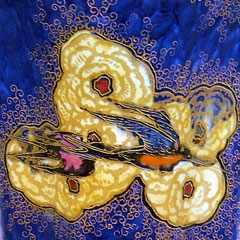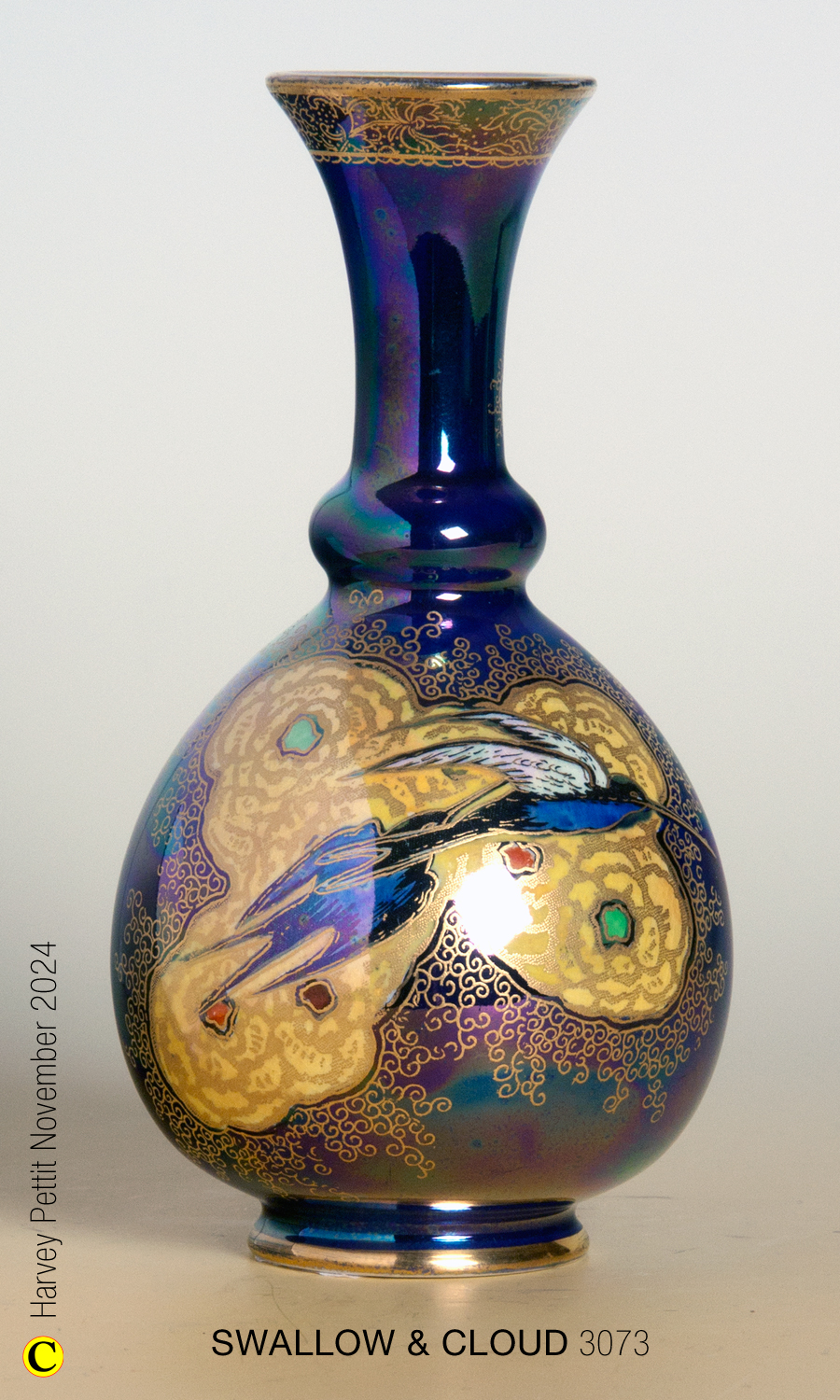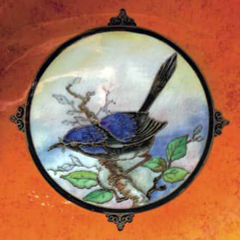Boulton's Birds - Part Eight

The SWALLOW & CLOUD pattern
Devised by Enoch Boulton
by Harvey Pettitwith border artwork by Barbara Anne Lee
This is the eighth of a series of articles on patterns that feature birds created by Enoch Boulton during his tenure as designer and decorating manager at the Carlton Works between 1921/22 and 1930.
The Mid 1920s - a Watershed

Underglaze painted on an ELECTRIC BLUE ground.
SWALLOW & CLOUD marks the beginning of many original, highly elaborate gold-printed patterns by Enoch Boulton and his successors. Such ornate designs were previously the domain of Carlton Ware's popular Chinoiserie creations and, before them, the high-end blushware patterns that used raised gold
—a finer and more delicate version of tubelining.
I estimate that SWALLOW & CLOUD was on the young Enoch's drawing board in 1925. Until that year, economic conditions had constrained the introduction of expensive decorations for about ten years. Trading during and after World War One (1914–18) was difficult for all potteries, partly due to labour shortages—so many had been killed or maimed during the conflict. The National Coal Strike of 1922 added to the challenges, since, without coal, the bottle ovens could not operate, and for the duration, the Potteries lay eerily smoke-free.
By 1924, things had begun to improve, and during that year, the elaborate NEW MIKADO and PERSIAN patterns were introduced. In 1925, one of Carlton Ware's most complex patterns, CHINALAND, was also on the drawing board along with CHINESE TEA GARDEN and TURKISH, ready to be introduced in 1926, together with SWALLOW & CLOUD, which I discuss here. Despite the disruptive nine-day General Strike in May 1926, I presume that the production of these new high-end decorations was already well underway, ensuring they were ready to be offered to Carlton Ware's many retailers and their customers.
To view the vase on the right fit your device's screen and/or enlarge, click or tap on it.
To return to this page, use your back button.
Origins
I began this series of articles with the SWALLOW pattern, one of Boulton's early designs for Carlton Ware, introduced in 1921 or 1922. It appears that SWALLOW & CLOUD is redrawn from the earlier pattern, as the birds have an identical outline, except for their beaks, which become much longer. Below is a comparison.

Bottom: SWALLOW & CLOUD 3243 printed in gold.
Underglaze painted against a handpainted BLUE ground.
To view this comparison fit your device's screen and/or enlarge, click or tap on it.
To return to this page, use your back button.
Every Cloud has a Black Lining
On some variants, the cloud is edged or traced with a narrow black line, making it stand out even more against its ground—you can see this in the image above. The wide, elaborate, and filigree-like fringe to the edge of the cloud makes the pattern zing. This embellishment may have been inspired by so-called 'vermicelli' decorations found on antique or even ancient pottery. On the cloud, the swallows are sometimes found in slightly different positions, presumably dependent on the shape being decorated and at the whim of the transferer. This suggests that a print of the birds was applied separately. If so, then probably, that part of the print of the cloud behind the birds' outlines had to be carefully wiped away before the prints dried and were 'hardened on' in a warm place, overnight perhaps, to be ready for the underglaze painting.

SWALLOW & CLOUD 3073.
The first part of the decorating process, after casting and the first firing in the 'biscuit oven', is to print the pattern onto the resulting hardened white body. Initially, the pattern is printed in 'smoke', a pale grey. Only when the underglaze painting is done, and the glaze applied and fired again, is the gold print applied. The gold print has to align exactly with the smoke print beneath.
To help you understand the process, on the right, I show an unfinished example of SWALLOW & CLOUD 3073 where something has gone wrong in the second firing, and as a consequence, the gold print has not been applied.
The image also illustrates that the area occupied by the cloud has to be masked from the dark ground—click or tap on the image to zoom in and enlarge. The transformation after the gold print is applied is dramatic. The rejected vase would have been sold off cheaply as a second.
The complexity of underglaze-decorated gold-printed patterns added greatly to the time it took to complete the arrangement, making them expensive to produce, though the results are often spectacular.
I am enormously indebted to Dorothy Faulkner (1917-2004), the 'Missus' in charge of the paintresses, for explaining these decorating techniques to me.
According to Carlton Ware's records, SWALLOW & CLOUD had nine variants. The first, 3073, shown at the beginning of this article, appears to have been the most popular. The same birds make another appearance on TREE & SWALLOW, which I write about in a subsequent article. The cloud, too, reappears being used on four other patterns. It certainly earned its keep!
Borders used with SWALLOW & CLOUD
A border was not designed specifically for SWALLOW & CLOUD. Instead, Horace Wain's narrow MIKADO BORDER BEAD was employed. Barb has redrawn this for us below.

Pattern records tell us that there was one version, 3286, that was simply printed in black and used the MAGPIE BORDER Bead, which again Barb has redrawn.

Date
As mentioned above, I estimate that SWALLOW & CLOUD was introduced in 1926. However, as I have also noted in other articles in this series, since few dates are given in Carlton Ware's surviving records, it is not always easy to establish the exact date of introduction of patterns or shapes.
Availability
The first of the pattern's nine variants was 3073, and the last was 3314.
This suggests that the pattern was probably in use until at least the early 1930s. Variant 3314 was specifically used to decorate the pen-stand shape shown below.

Underglaze painted against a MATT ORANGE ground. Reprinted in gold.
Image courtesy of the Collection of Chris Odgers.
For a border, pen-stands often used the CAMEO BEAD, originally designed for the CAMEO pattern—contemporaneous with SWALLOW & CLOUD.
You can see it on the pen-stand above; Barb has redrawn it for us below.

It appears that this pen-stand shape was made exclusively for Onoto, a brand name introduced in 1905 by Thomas De La Rue & Company, best known for stationery and banknote manufacturing. De La Rue used their Onoto brand name to market their innovative self-filling fountain pens.
It is plausible that the name Onoto is a play on the word 'note', as in banknote, or perhaps the phrase 'a note to'!

The next article in this series will be on three
bird patterns that must have been made for the growing Australian market, namely BLUE WREN, KING PARROT and KOOKABURRA.
V1 December 2024.
If new or more accurate information comes to light, I will update this page.
Barb would like to thank the members of our companion Facebook Group, who supplied good quality images to help her replicate the borders shown in this article.
